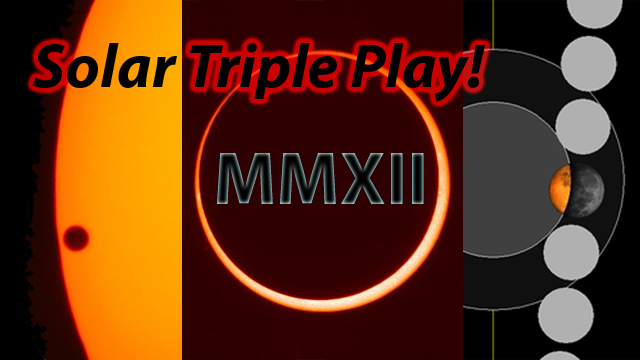
Get ready for a celestial sports extravaganza as you've never before seen—not all at once, anyway. Coming up in May and June this year is a matchup of three rare and beautiful celestial events, conveniently scheduled back to back to back for your viewing enjoyment.
Game 1: On May 20th, a solar eclipse will darken our skies and dazzle our eyes. From the Bay Area, it won't appear as a total solar eclipse, but it's not far off from one either. If you want to see the full force of this eclipse, when the Moon's disk lines up perfectly with the Sun's, you'll need to drive north and park within a swath of territory centered on Redwood National Park along the northern California coast, and inland, east and south, across Lassen Volcanic National Park. Here's a play diagram to help guide you.
Within the swath of land following the Moon's deepest shadow track you will experience what is called an annular solar eclipse—the brighter, though less famous sibling of a true total solar eclipse. An annular eclipse occurs when, at the time of this eclipse, the Moon is more distant from Earth than usual, its disk appearing smaller than the Sun's disk. So, even when perfectly positioned in front of the Sun, a rim of sunlight will shine out from all around the edge of the Moon's disk, creating a brilliant ring (or annulus) of golden sunlight for a few minutes. You may even look up at the sight and purr, "My precious…."
Here in the Bay Area, the eclipse will be a partial one—though a significant amount of the Sun will be covered, and Earth and sky will dim noticeably. The eclipse begins for us at 5:15 PM (PDT), when the Moon's disk first touches the edge of the Sun, gradually covering more of it until reaching maximum occlusion at 6:32 PM. The Sun will set while the eclipse is still in progress—but what an unusual sunset we may see!
The second heat of our Solar Triple Play airs two weeks later on June 4: a partial lunar eclipse—a sort of opposite, not-quite-instant replay of the solar eclipse; the yin to its yang. The same close alignment between Sun, Earth, and Moon that produced the solar eclipse produces this lunar eclipse as well, the related events two weeks (or half a lunar orbit) apart.
